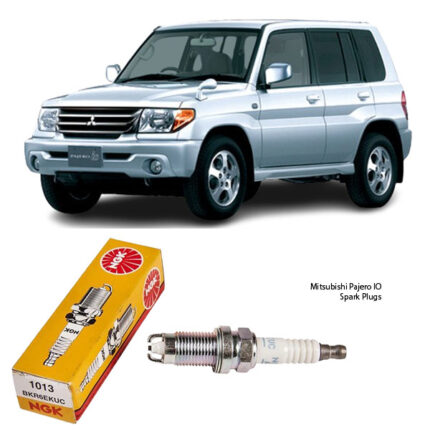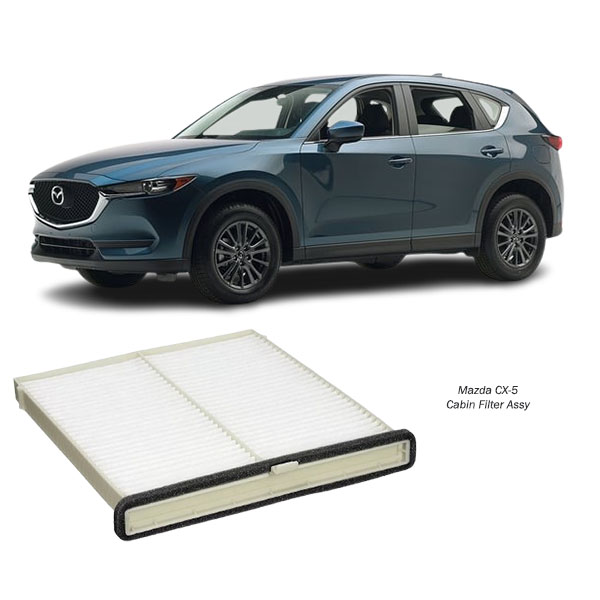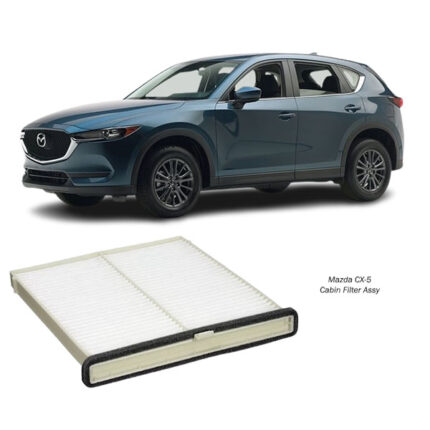Get Mazda CX-5 Cabin Filter KR11-61-J6X in Kenya
The cabin filter, also known as the cabin air filter, is a key part of a vehicle’s HVAC (Heating, Ventilation, and Air Conditioning) system. It is responsible for filtering the air that enters the interior of the vehicle through the ventilation system. This includes air drawn in from outside as well as recirculated air from inside the cabin.
The purpose of the cabin filter is to remove airborne particles such as dust, pollen, mold spores, exhaust gases, and even odors. It helps ensure that the air inside the vehicle remains clean, healthy, and comfortable for passengers. Without it, occupants would be directly exposed to a variety of allergens and pollutants, particularly in urban or industrial environments where air quality may be poor.
How the Cabin Filter Works
The cabin filter is usually made from pleated paper, synthetic fibers, or a combination of both. Many are also treated with activated carbon to trap gases and neutralize odors. It is mounted in the air intake path of the HVAC system, often behind the glove box, under the dashboard, or beneath the hood near the windshield base.
As the blower fan draws air into the vehicle’s ventilation system, the cabin filter acts as a barrier that captures harmful particulates. Some filters also have multi-layer construction, enabling them to trap progressively smaller particles—from leaves and dust to microscopic pollutants and airborne pathogens.
There are typically three types of cabin filters:
-
Particle Cabin Filters – Trap dust, pollen, and other solid pollutants.
-
Activated Carbon Cabin Filters – Also absorb gases and odors.
-
Electrostatic Cabin Filters – Use charged fibers to attract particles more effectively.
Benefits of a Good Cabin Filter
1. Cleaner Interior Air
A quality cabin filter captures airborne contaminants before they can enter the cabin. This results in a healthier breathing environment, particularly beneficial for those with allergies or respiratory conditions.
2. Improved HVAC Performance
When the cabin filter is clean, air can pass freely through the ventilation system, allowing the heater, air conditioner, and defroster to operate at peak efficiency.
3. Odor Reduction
Filters with activated carbon or baking soda neutralize unpleasant smells from exhaust fumes, pets, mold, and pollution, maintaining a fresher atmosphere inside the vehicle.
4. Protection Against Allergens
Cabin filters trap pollen, mold spores, and dust mites, which can cause allergic reactions. This makes them essential for individuals with asthma or seasonal allergies.
5. Prevention of Dust Accumulation
A functional cabin filter minimizes dust buildup on dashboards, vents, and other interior surfaces, reducing the frequency of interior cleaning.
6. System Longevity
By keeping dust and debris out of the HVAC system, a clean filter helps prevent wear and clogging of components such as blower fans and heater cores.
Disadvantages of a Worn or Poor-Quality Cabin Filter
1. Reduced Airflow
As contaminants accumulate, the filter becomes clogged. This restricts airflow, making the HVAC system work harder and reducing its effectiveness.
2. Foggy Windows
A dirty cabin filter can hinder the defroster’s ability to clear condensation, reducing visibility and potentially increasing driving risk.
3. Unpleasant Odors
If the filter is saturated with moisture or debris, it can begin to emit a musty or moldy smell inside the cabin.
4. Increased Allergies
Instead of blocking allergens, a clogged filter may allow them to pass through or, worse, become a breeding ground for mold and bacteria.
5. Strained HVAC System
Restricted airflow can overwork the blower motor, potentially leading to premature failure and costly repairs.
6. Noise Increase
Blocked airflow may cause the fan to become louder, and particles trapped in the filter can sometimes create a whistling or buzzing noise.
Signs That the Cabin Filter Needs Replacement
-
Reduced Airflow from Vents
Weak airflow even at high fan settings is a clear indicator that the filter may be clogged with dust and debris. -
Unusual or Musty Odors
A persistent bad smell, especially when using the air conditioner or heater, can be due to a dirty cabin filter harboring mold or bacteria. -
Increased Allergic Reactions
If passengers experience more sneezing, coughing, or irritation while inside the vehicle, the cabin filter may be failing to trap allergens. -
Foggy Windows
Slow or inefficient defogging performance may be linked to a restricted airflow caused by a blocked filter. -
Noisy HVAC Operation
A clogged filter can lead to unusual sounds as the blower motor struggles to push air through the system. -
Visible Dirt or Debris
Upon inspection, a dark, dusty, or leaf-filled filter clearly indicates it’s time for a replacement.
How to Replace a Cabin Filter
Replacing a cabin filter is generally a simple maintenance task that can be performed with minimal tools. It is recommended to consult the vehicle’s manual for the exact location and procedure.
Basic Tools Needed:
-
Screwdriver (if needed)
-
A new cabin air filter
-
A clean cloth or vacuum for cleaning the filter housing
Step-by-Step Replacement Guide:
-
Locate the Cabin Filter Compartment
Most cabin filters are located behind the glove box, under the dashboard, or under the hood at the base of the windshield. -
Access the Filter
If behind the glove box, remove the glove box by unhooking tabs or unscrewing fasteners. Carefully lower it to expose the filter housing. -
Remove the Old Filter
Slide out the old filter. Note its orientation—most filters have an arrow indicating airflow direction. -
Clean the Housing
Use a damp cloth or vacuum to remove any accumulated dust, leaves, or debris inside the filter slot or housing. -
Install the New Filter
Insert the new filter with the airflow arrow pointing in the correct direction. Make sure it fits snugly in the slot. -
Reassemble Components
Secure the filter housing cover and reinstall the glove box or any panels removed. -
Test the System
Turn on the blower and check for normal airflow and any unusual sounds.
When to Replace the Cabin Filter
Most cabin filters should be replaced every 12,000 to 20,000 kilometers or at least once a year, depending on driving conditions. Vehicles used in dusty, industrial, or high-traffic areas may require more frequent replacement. Seasonal changes—especially spring and fall—are ideal times to inspect or replace the filter due to pollen and leaf debris.
Follow us on Facebook for more parts.





Reviews
Clear filtersThere are no reviews yet.